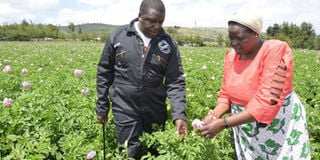My secret to peeling money off potatoes despite poor prices

Richard Rop with his wife Rachael in their potato farm in Njoro. Besides potatoes, Rop also grows peas, maize, millet, vegetables like cabbages and spinach, and fruits such as loquat and avocados. PHOTO | FRANCIS MUREITHI | NATION MEDIA GROUP
What you need to know:
- Rop farms mainly potatoes but he also keeps cows and grows trees, among other crops.
- He uses a fork to harvest, which is the best way as one is assured they will dig up at least 90 per cent of the entire tubers in the soil.
- Besides tough market, potato blight is common in the area due to heavy rains, therefore, he has to spray the crop with insecticides at least three times.
- The couple keeps five Friesian cows under zero-grazing, two that produce about 20 litres of milk daily, selling a litre at Sh30.
Some 4km off the Njoro–Mau Narok Road at Mauche centre, you will find Segutek sub-location, where farmer Richard Kipsang Rop farms on 15 acres.
We meet him dressed in a navy blue overall, a pair of gumboots and carrying a slasher in his right hand as he walks on the edges of his vast potato farm.
Rop farms mainly potatoes but he also keeps cows and grows trees, among other crops. His flourishing four-acre potato plantation is a spectacle to behold.
To begin with, he has planted napier grass between blocks of potato crops, which besides acting as fodder the grass helps in reducing rainwater erosion that sometimes washes fertiliser downstream.
The grass is crucial as his potato plantation lies on a hilly section of his farm and the area experiences heavy rains.
Direct exposure
To get maximum yields, Rop says he starts by preparing the land, tilling twice to have a fine tilth. He, thereafter, adds manure and mixes well with the soil.
“After that I dig shallow trenches that are 70–100cm apart and add manure again or DAP fertiliser at the rate of 200kg per acre before planting the seeds at 25-30cm apart and covering with 10cm of soil.”
Once the crop reaches about 30cm, he mounds soil around the stem so that they are well covered to almost their height to protect the tubers from direct exposure to the sun.
“The mounding of the soil around the stems should be done at least twice to be assured of big tubers and maximum yield. The crop is harvested when the leaves have dried indicating the tubers are mature.”
EXTENDED BAGS
He uses a fork to harvest, which is the best way as one is assured they will dig up at least 90 per cent of the entire tubers in the soil.
“Using the normal hoe when harvesting is not recommended because it will cut many of the tubers leading to losses. No one wants tubers that partly exposed.”
Rop, who plants the crop twice in a year, harvests at least 400 bags per season, with prices ranging from Sh2,000 and Sh2,500.
However, it is not all rosy for Rop, who farms with his wife Rachel, the chief of Segutek location in Njoro.
“Selling in extended bags, a practice that has refused to go away despite a law to curb it is hurting potato farmers.
Some unscrupulous traders are buying our produce at between Sh1,000 and Sh1,500 for the over 100kg bag ignoring the recommended packaging of 50kg bag.
Those farmers who insist on the correct bag are shunned,” adds Rop, 50, who is the Executive in-charge of Water, Environment, Energy and Natural Resources at the Nakuru County Government.
However, to beat the crafty trader, he says timing the planting season is critical.
“I plant around December so that I harvest in February or March when there is shortage and prices are favourable,” says Rop, who also sells the produce to fast food outlets, restaurants, schools, and institutions.
Besides tough market, potato blight is common in the area due to heavy rains, therefore, he has to spray the crop with insecticides at least three times.
MIXED FARMING
“I spray the crop when it shoots, before flowering and during weeding,” says Rop, who plants the Shangi variety that is popular for making chips (French fries).
Besides potatoes, Rop also grows peas, maize, millet, vegetables like cabbages and spinach, and fruits such loquat and avocados.
“I do mixed farming. I don’t depend on potato alone. Last year, for instance, maize failed due to lethal necrosis diseases but I had diversified my risks. I have also dedicated one acre to cypress trees,” says Rop, who has planted 3,000 trees that he hopes would mature in 2023.
Rop’s wife assist him in managing the farm started in 2007.
“We sell peas seedlings to farmers. Last year, we harvested 30 bags which earned us Sh400,000 after deducting expenses,” says the mother of six children.
The couple keeps five Friesian cows under zero-grazing, two that produce about 20 litres of milk daily, selling a litre at Sh30. From his maize farm, he gets 30–35 bags and sells each at an average of Sh2,000.
***
Get It Fast
Expert's view
- Dr Lusike Wasilwa of the Kenya Agricultural Research and Livestock Organisation, says potato is an important crop as a hectare produces up to 9.2 million calories.
- “Compared to maize, it can be more profitable because it can be cooked in many different ways. Its peels can also be used as bio-fuels while its sludge could be used as organic matter and is good for improving soil fertility,” says Dr Wasilwa, noting the industry is worth Sh50 billion.
- Potato prices depend who is buying, availability in the market and the sizes of the produce.
- There are about eight potato seed varieties namely Ambition, Arizona, Arnova, Kenya Karibu, Kenya Mavuno, Shangi, Sherekea and Tigoni.




